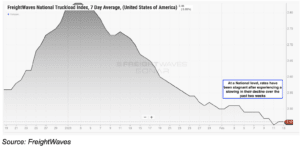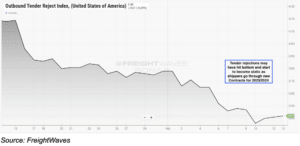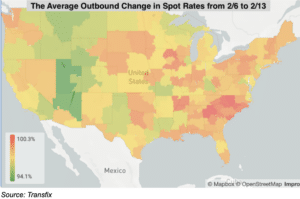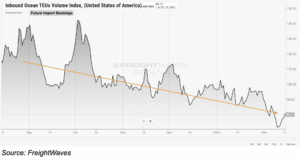The midweek market update is a recurring series that keeps shippers and carriers informed with market trends, data, analyses, and insights.
Transfix Take Podcast | Will Tender Rejections % Increase Create a Market Swing?
Jenni: Hello, and welcome to an all-new episode of the Transfix Take podcast, where we are performance driven. It’s the week of February 15 and we’re bringing you news, insights, and trends from our market expert, Justin Maze. Now, Maze, I have to say, although it’s passed, happy Valentine’s Day.
Maze: Hey, Jenni, great to see you again, and happy Valentine’s Day to you as well.
Jenni: Thank you, Maze. Now, my favorite thing about Valentine’s Day is not the flowers, but rather the logistics of flowers.
Maze: That’s right, Jenni. A lot of people don’t realize that Valentine’s Day does create a seasonality impact for the freight transportation sector. In fact, Valentine’s Day usually contributes to tighter markets in southern Florida, and this is due to the imports of flowers from South America, especially Colombia. It heats up the truckload market just as Valentine’s Day heats up romance for everyone else.
Jenni: Love that analogy. So, you know, I’m going to ask you, what else did Valentine’s Day heat up, Maze?
Maze: Well, Jenni, Valentine’s Day did heat up capacity in the Southeast, especially Florida, driving rates a little bit higher by a slim margin. But nationally, the market has remained static when it comes to spot rates. This is a reason why I believe we are potentially seeing a bottom of spot rates in the coming six to eight weeks like I mentioned last week. The only regions I really think that continue to have a good amount of room to decline is going to be the Midwest and Northeast as they move out of their tight seasons.

Jenni: With weather neutralization like we’re starting to see in the Northeast with that 50, 60 degree weather mark, we’ll start to see more normalcy. But where are we in terms of rejections?

Maze: Looking at rejections, I only second this opinion as we are starting to see a floor hit with tender rejections for contract freight. We saw a slight increase this past week, in fact, and we are starting to see more of a static trend rather than a continued decline that we’ve seen since the beginning of the year.
Jenni: So here’s the name of the game. More tender rejections typically lead to tighter capacity in the market, which means that carriers are playing a game where they could potentially gain control again of the spot market. But we’ve still got a ways to go in order to see that swing.
Maze: That is true, Jenni. There still is a large spread between contract and spot rates, although contract rates are continuing to slowly decline. The only issue is that this gap is really brought on by contract freight that sits with brokers and large asset companies.The spread isn’t necessarily where market rates can continue to drop for small and mid-sized carriers. These carriers are already in that position. It’s going to be interesting in the coming months as all of these new RFPs with large shippers get priced and go live and really start squeezing the margin potential for brokers and large asset companies. It will be interesting to see how long it takes for that tender rejection on top contract freight to start ticking upward, leaking more spot freight into the spot market.
Jenni: I think we’ll see it at the end of Q2. But where do you stand on this issue, Maze?
Maze: I do think it’s safe to say with tender rejections below 3.5% still, we have some time before anything dramatic happens in the market. On top of that, we are looking at some large winter storms moving in this week that could play a hand in shifting and tightening capacity in the Southwest, particularly in Arizona and New Mexico, as they were anticipating some pretty significant snowfall for this time of year. Also, Colorado and Utah are still battling some snowstorms. These big storms are rolling across the Southwest and up through the Midwest. But, Jenni, like I’ve said many times, I think we are in a place with loose enough capacity that we can absorb these somewhat significant storms. I do not believe we’re going to see anything that plays out similar to what we saw in the last few weeks when the South, Texas, and Arkansas and even parts of Louisiana saw an extremely deep freeze closing down facilities for several days.
Jenni: We’re looking at about five inches of snow for the Dakotas into northern Minnesota and then probably about six inches at best for the Colorado and New Mexico area, but we’ll keep an eye on it. But that said, Maze, you know what it’s time for.

Maze: Let’s do it, Jenni. The Valentine’s week regional breakdown. The Northeast: I do believe we’ll continue to see spot rates decline at a faster rate than most other regions. That is unless there is a winter storm brewing that we do not know about. But Jenni, the weather up in the Northeast is supposed to be quite warm for this time of the year. I believe that freight going down to the Southeast and to the West Coast will continue to see tighter capacity with stagnant or slightly rising rates. But freight leaving the Northeast going to the Midwest, Coastal, and the South will continue to see decreases.
Jenni: Great. Now what about the Midwest? I know it has somewhat similar seasonality trends as you just described.
Maze: I also believe we are going to continue to see rates fall unless it’s going to the West Coast. Freight staying within the Midwest will likely see the largest decreases week over week. And for most of the Midwest, as we start to leave winter, even though there is some snow coming this week, as we start to see the end of winter, we will likely see more loosening in the coming weeks, greater than other regions such as the West Coast and Southeast.
Jenni: Now let’s jump on down to the Southeast Coastal region.
Maze: The Coastal region in particular has been stubborn lately, especially in the North Carolina markets. We haven’t really seen any relief in price, and this week we are going to probably see flat week-over-week changes. Freight going even farther down south to destinations like Florida are going to continue to be tough as capacity pushes away from trying to go down to Florida as it also loosens up.
Jenni: Okay, so as we speak about Florida, why don’t we move down to the Southeast, Maze?
Maze: Last week and to be honest, for the last three weeks, we’ve been calling out tighter capacity in the Southeast, especially Florida, again thanks to the wonderful Valentine’s Day holiday. I do believe that Florida is going to start seeing some loosening, although it’s not going to take place until later this week. For Atlanta which is one of the largest freight markets by volume, we’ve continued to see tighter capacity last week, more than I actually would have anticipated. I do believe this week brokers and carriers will be able to continue to hold rates stagnant in the spot market. Additionally, the Memphis market has continued to be tight, primarily due to weather events that have happened over the last three weeks. This week unfortunately is not looking any different. With major thunderstorms approaching the Memphis, Tennessee market, I believe that we are actually going to continue to see rates slightly increase through the week.
Jenni: Lots of weather to watch around the continental United States that we’ll keep an eye on. Now, Maze, let’s go over to the West Coast.
Maze: Freight leaving the West Coast is going to continue to see rates decrease. The only destination for freight originating in the West Coast to see rates increase is if it’s picking up in the Pacific Northwest going back down to one of the major shipping meccas in California. Other than that, freight is going to continue to be stagnant for inter-west coast movements.
Jenni: Okay, Maze, and last but not least, what’s going on with the South?
Maze: The South has been a region to keep an eye on for the last several weeks due to all the storms or winter storms to severe thunderstorms. I believe that the major freight market for the South, Dallas and Houston, is going to loosen. It is likely that we are going to start seeing some capacity issues, although I do not believe they’ll be too significant.
Jenni: Shippers need to be on the lookout for carriers that are running late or may have delays, obviously due to inclement weather. We are always advising their safety first, but Maze, any final thoughts before we move on?
Maze: Jenni, as we reach the midway point in February, I think there’s two core things that we need to continue to monitor and keep an eye on, as they are leading indicators of what is to come in the next few weeks to few months, and that is what’s happening with inventory and imports. The two are so interconnected.
Jenni: And based on the numbers from Q1 and projections for Q2 and even Q3, it really doesn’t look like we’re going to see a significant jump in those imports based on consumer consumption.

Maze: I’m sure a lot of shippers are monitoring their inventory levels very closely because the cost-to-store inventory in warehouses has only increased and is expected to increase faster than the rate of inflation. So this means that shippers do not want to have extra inventory on hand and pay a premium to house it. So will shippers wait till the last second and all rush to order freight for imports, or will it be better planned out, leading to less congestion? It’s all in that crystal ball that we need to start shaking up in the coming weeks.
Jenni: Time will tell with that. We’ll see you next week with an all new episode of the Transfix Take Podcast.
Until then, drive safely.
DISCLAIMER: All views and opinions expressed in this podcast are those of the speakers and do not necessarily reflect the views or positions of Transfix, Inc. Or any parent companies or affiliates or the companies with which the participants are affiliated and may have been previously disseminated by them. The views and opinions expressed in this podcast are based upon information considered reliable, but neither Transfix, Inc. Nor its affiliates, nor the companies with which the participants are affiliated warrant its completeness or accuracy and it should not be relied upon as such. All views and opinions are subject to change.




